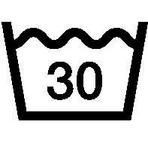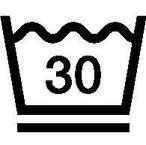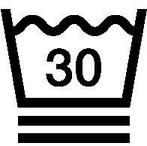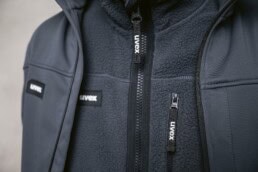Workwear is subjected to heavy wear and tear every day and therefore requires special care to maintain its function and longevity. Whether protective clothing or everyday workwear – proper cleaning not only contributes to hygiene, but also ensures safety and comfort. From the choice of detergent and the right temperature to professional care by laundries, there is a lot to consider. This guide gives you valuable tips to ensure that your workwear lasts a long time and retains its protective functions.
Cleaning uvex workwear: For your safety
We do everything we can to design and manufacture durable, high-quality products. In every product development we focus on repair-friendly processing (e.g. reflective strips, zips, buttons), long service life, long-term product availability and the use of suitable fabrics and materials.
The majority of our products are designed to be used by laundries and textile service providers. However, since processes and conditions can vary greatly between laundries, we recommend first subjecting our workwear to a wash test under the specific conditions. This is the only way to ensure the longest possible lifespan of the work and protective clothing and to reliably exclude any complaints.
Right from the development stage, we incorporate our quality testing with our in-house washing laboratory in order to check the materials we use in accordance with ISO 6330.

In addition, we test them according to ISO 15797, providing our customers with a reliable basis for use in industrial laundry.
However, there are innovative PPE fabrics and fibers that offer special protective performance, which may not meet the requirements of ISO 15797. Here, it is necessary to weigh whether the desired application area and the intended product properties allow for a compromise regarding the cleaning and care of workwear in industrial ISO laundry.
Our washing recommendations are based on the information from our suppliers, our internal wash tests, and, of course, the specifications in the respective type examinations.
Now it’s up to you: The more carefully you wash and care for your workwear, the longer you can use the protective clothing – and save valuable resources in the process.
Would you like an overview of our range right away? You can find a list of products here: Workwear from uvex – Professional clothing for every need.
Is it allowed to wash your workwear at home?
Proper care of your workwear maintains its functionality and extends its lifespan. On the inside of the products, you will find the corresponding care symbols that show you exactly how to clean and maintain your workwear.
Why is clean workwear important?
Especially when wearing protective clothing, adhering to the care instructions is crucial for safety and ensures hygiene and safety standards. Clean workwear is important because it not only enhances professional appearance but also increases safety and hygiene in the workplace.
When washing your workwear at home, there is a risk of contamination from incorrect chemicals. Additionally, reflective strips may no longer reflect if the wrong detergent is used. These are just a few examples of the risks that can compromise the protection of workwear when washed in private households. Even with our everyday clothing that does not come into contact with harmful substances, there are several things to consider. Here, the washing and ironing temperature is particularly important.
PPE Cleaning: Industrial Laundry Service for Optimal Protection
Our recommendation for cleaning your PPE (personal protective equipment): It should only be cleaned by an industrial laundry service! This service pays attention to the pH value of the detergent when cleaning workwear. Your benefits:
- Avoiding contamination
- Ensuring that the protection of your PPE is fully maintained
- Extending the lifespan of your PPE
How do you clean your workwear yourself?
Whether your work coat needs cleaning or you want to wash your work pants, proper washing is crucial to extend the lifespan of your clothing. The best way to care for your workwear is to follow these tips before cleaning your workwear:
- Follow the care label
- Proper sorting
- Stain treatment / pre-treatment as needed
How often should workwear be washed?
Proper care of workwear is crucial to both extend the lifespan of the clothing and minimize cleaning costs. Employers should provide clear guidelines for the care and cleaning of workwear to ensure that the clothing remains clean and functional at all times. A washing machine is often the most effective method for cleaning workwear, but it is important to follow the instructions on the labels to avoid damage.
For example, in professions such as gastronomy, it is particularly important to wash workwear regularly to comply with hygiene regulations and present a professional appearance. Different stains can be removed in various ways:

Sweat
Sweat, especially in combination with intense UV radiation, can have a corrosive effect and lead to unsightly stains and discoloration. Therefore, we recommend changing workwear regularly and washing it immediately.
Deodorant
Even antiperspirant deodorants cause unsightly stains, especially on white textiles. It can help to soak the affected areas in water with lemon juice or in water with denture cleaner and then wash according to the care instructions.
Oil and Grease
Many greasy stains can be removed well from cotton or synthetic materials with cornstarch or potato flour. Sprinkle evenly on the stain, let it sit, brush it off, and then wash according to the care instructions. Treat heavy machine oil with special stain removers available on the market.
Paint, Pen and Glue
You can’t avoid special stain removers here. Please follow the manufacturer’s instructions exactly.
Coffee, Tea, and Juice
Water-soluble stains are no problem for today’s detergents, even at low temperatures. For strongly coloring fruits and beverages, the use of liquid gall soap has proven effective.
Detergent for Household Laundry
Choosing the right detergent plays a crucial role in cleaning and caring for your workwear. Whether for daily laundry or special requirements, the right detergent protects the textiles, preserves the protective function of your workwear, and helps to make washing processes efficient and environmentally friendly. The table gives you an overview of which detergent is suitable for which laundry:
| Detergent | Suitable for |
|---|---|
| Compact, Universal, or Heavy-Duty Detergent | These almost always contain bleaching agents and optical brighteners, making them suitable for light and white laundry made of pure cotton. However, they can damage all colored and white textiles made of fiber blends or synthetic fibers. |
| Color Detergent | These do not contain optical brighteners and are particularly suitable for colored textiles. |
| Delicate Detergent, Wool or Silk Detergent | These are particularly suitable for delicate fabrics. |
| Special Functional Detergents | These are, for example, to be used for laminates. |
Dosage of Detergents
Please follow the dosage recommendations of the detergent manufacturers and consider the hardness of the tap water. Overdosing harms the textiles and the environment.
Does this translation meet your needs? If you have any more questions or need further assistance, feel free to ask!
Effective Work Clothing Cleaning: How to Achieve Optimal Results
Proper cleaning of service clothing is crucial for maintaining its functionality and longevity. Whether it’s the care of workwear or special protective clothing, thorough and professional cleaning ensures that your clothing remains hygienically fresh and retains its protective properties. With these tips, you will achieve optimal results and extend the lifespan of your workwear.
Dirt and Stain Removal through Bleaching
Bleaching is a process carried out in an aqueous medium before, during, or after washing to improve dirt and stain removal and/or to increase the degree of whiteness. Bleaching agents used include active chlorine (e.g., Javelle water) or chlorine-free, active oxygen-releasing products (contained in heavy-duty/universal detergents).
| Type of Bleaching | Detergent |
|---|---|
| All types of bleaching | Chlorine or oxygen bleach allowed |
| Oxygen bleach | Only oxygen bleach contained in universal detergents. Chlorine bleach is not allowed. |
| Do not bleach | Bleaching is not possible. Use only bleach-free detergents like color detergents. Be cautious with stain removers and test them at an inconspicuous spot if in doubt. |



Washing Process/Treatment
Pay attention to the washing temperature according to the care label. The washing symbol on the care label indicates whether household washing is possible or not, and applies to both hand and machine washing. The numbers in the wash tub correspond to the maximum washing temperatures in degrees Celsius that must not be exceeded. A bar below the wash tub requires gentle treatment with reduced laundry load and low spin speed. The double bar means very gentle treatment with reduced mechanics (e.g., wool wash).
Laminated or coated materials can also be machine washed, ideally on a gentle cycle.



Rinsing and Spinning
Adequate rinsing helps remove detergent chemicals and lower the pH value of the local tap water. To protect your laundry and increase its lifespan, we recommend avoiding the use of fabric softener. Fabric softener clogs the pores and thus reduces breathability. Detergent residues, fabric softeners, and other auxiliaries/additives can negatively affect the protective function and repellent properties of the fabric. For laminated or coated materials, a second rinse cycle and a low spin speed are recommended.
Why pH Value is So Important
When washing garments, the use of an acid treatment after thorough rinsing is highly recommended. The main purpose of the acid is to lower the pH value of the fabric from the alkaline detergents. This has the clear advantage of reducing the possibility of dermatological reactions due to high pH levels.
The use of acids has no negative impact on flame resistance.
To ensure that all traces of detergent alkalinity are neutralized, acid can be added to the final rinse cycle in the washing machine. For suitable products and instructions for use, please contact your detergent and chemical supplier.
Proper Drying: How to Keep Your Laundry in Top Shape
Even when drying, the care label must be observed. The care instructions refer to household laundry. Suitability for industrial laundry, including drying, is marked separately.

Drying Process
The dryer symbol (circle in a square) indicates whether the product is suitable for tumble drying or not and applies to dryers and washer-dryers. The number of dots in the symbol indicates the maximum temperature that can be used for the machine drying process.
| Drying Process | Temperature | Washing Process |
|---|---|---|
| Drying in a tumble dryer possible | Up to 80°C | Normal process |
| Drying in a tumble dryer possible | Up to 60°C | Gentle process |
| Do not tumble dry |



Laundry should be well-drained before drying, primarily through the chosen spin cycle. It is also advisable not to overfill the dryer drum and to only put items with the same drying duration together in the dryer. An additional 10-minute drying without heat at the end of the drying cycle cools the clothes down and helps to avoid unnecessary creasing. Furthermore, clothes should not be left in the hot dryer after the drying cycle is complete. Alternatively, you can skip the dryer and simply air dry the garment – preferably hanging on a hanger or drying rack. Ideally, choose a place without direct heat or sunlight.
Ironing Temperatures for Different Irons
The table indicates the temperature ranges of different irons. For the irons in use, these settings are sometimes associated with specific raw materials that you should definitely pay attention to.
| Iron | Maximum Soleplate Temperature | Notes | Symbol |
| Standard Iron | 210 °C |  |
|
| Steam Iron | 120 °C | Ironing with steam can cause irreparable damage | |
| Travel Iron | 160 °C |  |
|
| Ironing Machines | 120 °C |  |
|
| Do not Iron | Ironing not recommended |  |
|
Things to Consider When Ironing
Some elements of workwear should preferably be ironed only from the inside to avoid damage. These include:
- Reflective strips
- Prints
- Patch emblems
Reactivation and Impregnation of Your Weatherproof Workwear
Reactivating and impregnating equipment are essential measures to maintain the functionality and longevity of textiles. Weatherproof workwear, in particular, benefits from regular care. Impregnation serves to renew the water- and dirt-repellent protective layer, while reactivation restores the original material properties. Special washing and care products are used for this purpose.
Reactivation
If the workwear has a durable water-repellent finish, refreshing and/or activating this finish is occasionally necessary. To achieve optimal reactivation of the water-repellent finish, heat and time are required. There are two methods for reactivating the finish:
1. Tumble Dryer
For activating the finish, the heat of the drying process is important. If it is not excluded on the care label, you can put the garment in the dryer at a low temperature for about 30 minutes. If your dryer shuts off early, add a damp towel to stimulate the moisture sensor of your dryer. Afterwards, you can simply let a few drops of water run over the outer fabric. If the water beads off the outer fabric, the reactivation has been successful.
2. Ironing
Ironing and pressing have a positive effect on reactivation. To do this, place a towel between the garment and the iron and iron the dry garment at a low temperature without steam.
3. Impregnation
Since the impregnation diminishes over time – for example, due to mechanical stress – it must be renewed with appropriate impregnation agents. This is the only way to ensure that the jacket or rainwear retains its functionality permanently.
How do I know when to re-impregnate?

If water no longer beads off the workwear as usual after washing and drying, it’s time to refresh the impregnation with appropriate impregnation agents/methods. Once the garment is dry, you can check if the material needs re-impregnation by performing a beading test. Water droplets should bead easily. If the water droplets do not bead, it’s time to renew the impregnation. There are options to either wash in or spray on the impregnation. Dirt, sweat, and the use of fabric softeners can prevent the even application of the impregnation agent.
How to Impregnate Properly
First, wash your workwear without fabric softener and then impregnate it. Always follow the instructions on the care label of the textile and the instructions on the impregnation agent. Ensure that these requirements are compatible.
Methods of Impregnation

To maintain the water-repellent properties of clothing, there are various methods of impregnation. These include wash-in impregnation in machine washing, hand washing with special impregnation agents, and spray impregnation. Each method protects the material from moisture and dirt.
Wash-in Impregnation in the Washing Machine
Impregnation agents for wash-in use are easiest to apply in the washing machine. Use a gentle wash cycle for this.
- Close all zippers and wash the jacket.
- Remove all detergent residues from the detergent compartment and add the required amount of impregnation agent as described by the manufacturer into the detergent compartment. This step is omitted for combination detergents that already contain impregnation.
- Set the washing machine to a synthetic or gentle wash cycle with the specified temperature and – at most – gentle spinning. Ideally, skip the spin cycle altogether.
- Afterwards, let the garment air dry. Avoid direct heat sources and sunlight.
- If necessary, activate the impregnation through heat if your impregnation agent requires heat treatment and the clothing has been air-dried. Again, follow the manufacturer’s instructions.
Wash-in Impregnation by Hand Washing
If you prefer not to clean your jacket or similar delicate workwear in the washing machine but still want to treat it with wash-in impregnation, you can also do this by hand washing.
- Close all zippers and wash the jacket according to the manufacturer’s washing instructions.
- Place the freshly washed jacket in a bowl with lukewarm water and add the required amounts of water and impregnation agent as specified by the manufacturer.
- Wash the jacket thoroughly by hand in the solution. Gloves are recommended.
- Rinse the jacket thoroughly after washing.
- Then let it air dry. Avoid direct heat sources (heater) or sunlight.
- If necessary, activate the impregnation through heat if your impregnation agent requires heat treatment and the clothing has been air-dried. Again, follow the manufacturer’s instructions.
Spray Impregnation
To impregnate jackets and rainwear, there is another option to renew the impregnation: spray impregnation. Spray impregnations are particularly recommended for winter jackets, winter workwear, and clothing with insulation filling. Impregnation sprays are suitable for all jackets and other garments, making them a universal solution. The spray is simply applied evenly only to the outside of the textile. With the impregnation spray, you can also treat worn areas specifically and thoroughly. The method of application varies slightly depending on the manufacturer.
As always: Follow the manufacturer’s instructions and wash first, then impregnate.
- Lay out your jacket in a well-ventilated area for impregnation. A drying rack is ideal.
- Spray the agent evenly onto the outer material from a short distance.
- Let the impregnation sit for a few minutes and work any excess agent into the clothing with a damp cloth. Then let the garment air dry in a shaded area. Avoid direct heat sources (heater) or sunlight.
- If necessary, activate the impregnation through heat if your impregnation agent requires heat treatment and the clothing has been air-dried. Again, follow the manufacturer's instructions.
Industrial Care and Professional Textile Cleaning
PPE, or personal protective equipment, should only be cleaned by an industrial laundry service. Professional post-treatment to neutralize chemicals or protect against germs is also part of the service. Contamination with everyday clothing is naturally excluded. This ensures that the protection of the PPE remains intact and you do not take any risks either at work or at home.
The symbols on the care label indicate how the clothing can be professionally cleaned. The letters in the circle denote the solvents (P, F) used in dry cleaning or wet cleaning (W).




With the mentioned care instructions, workwear remains functional and durable for longer. If the workwear is suitable for industrial laundry according to ISO 15797, it ensures that it withstands the highest demands during washing. To ensure that your clothing remains not only clean but also safe, we have added our new ‘industrial wash’ symbol to our industrially washable products.
How does Industrial Wash work?
Industrial wash 1
- Wash temperature: 60°C
- Drying process: Tunnel finisher or tumble dryer
- pH value: Remains below 10
- Reflective strips are protected
- No optical brightening by the detergent
Industrial wash 2
- Wash temperature: 75°C
- Standard: EN ISO 15797 remains ensured
- Drying process: Tunnel finisher
- pH value remains below 10
- No optical brightening by the detergent
Properly Storing Protective Clothing: Ensuring Functionality for Years
Due to wear and tear from use and cleaning, the material of work clothing naturally ages and deteriorates to varying degrees depending on the level of stress. Therefore, before and after washing, the clothing should be inspected for visible damage. Repairs should only be carried out by skilled personnel using materials with the same protective functions and protection classes. If irreparable damage occurs, the clothing must be replaced.

Currently, there are no indications that clothing, when properly stored (in original packaging, dry, dust-free, dark, no major temperature fluctuations, etc.), cannot retain its properties for many years. The user should inspect protective clothing for damage according to the aging factors mentioned above before use and replace it if necessary. The date of manufacture (year and month) is indicated on the sewn-in label of the product.
Laminated or coated work clothing should ideally be stored hanging or loosely folded. It is important that it remains dry!
Workwear from uvex: Professional Clothing for Every Need
Whether it’s for craftsmanship, industry, or logistics – uvex offers a comprehensive range of workwear tailored to various applications. As a manufacturer with decades of expertise, we impress with a wide selection of well-thought-out professional clothing that is used in various business sectors and stands out for its functionality, comfort, and durability:
- Pants: Robust work pants with optimal fit and practical pocket solutions. Here you will find both long-legged models and short Bermudas for warm workdays.
- Shirts: Discover our shirts made from breathable materials for comfortable wear during everyday work.
- Jackets: Weatherproof work jackets for indoor and outdoor use.
- Vests: Benefit from our versatile vests equipped with thoughtful details.
- Functional Underwear: The innovative functional underwear from uvex ensures a pleasant body climate, even during physically demanding activities.
For particularly demanding work areas, uvex also offers specialized protective clothing that is precisely designed for critical applications. Whether in industry, construction, or laboratories – the range reliably covers numerous uses.
- Chemical Protection: High-quality chemical protection clothing is resistant to aggressive substances and hazardous liquids.
- Welding Protection: Use our heat- and flame-resistant welding protection clothing that repels glowing sparks.
- High-Visibility Clothing: Eye-catching multifunctional high-visibility clothing in neon colors and reflective elements for maximum visibility in road and construction traffic.
- Cut Protection: Reinforced cut protection clothing features durable materials necessary for working with sharp tools or machinery.
- Knee Protection Clothing: Strong knee protection clothing relieves stress during kneeling activities and prevents long-term strain injuries.